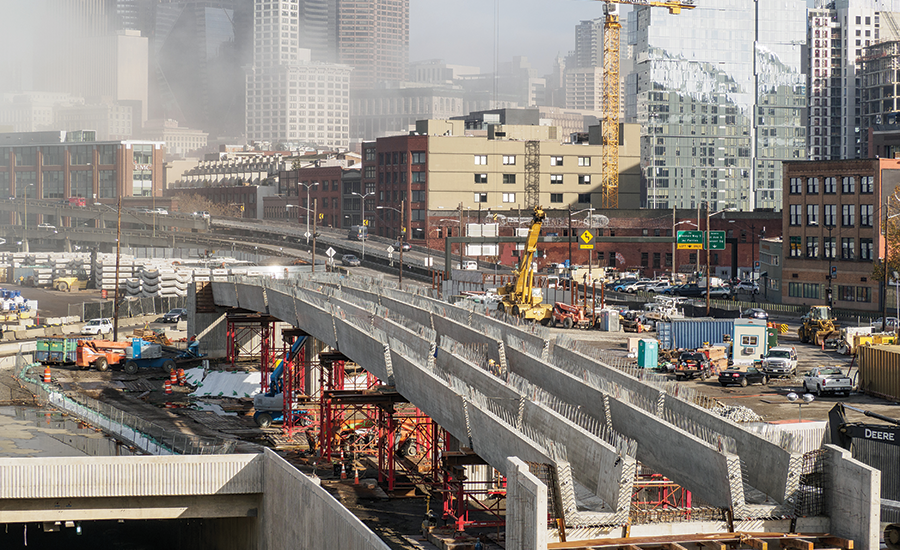Moving from the lab to the field, a highway off-ramp bridge under construction in Seattle features memory-retaining metal rods and bendable concrete designed to provide the structure with flexibility sufficient to withstand a major seismic event.
Currently under construction in downtown Seattle, the Washington State Dept. of Transportation project uses 15 years of research from Dr. Saiid Saiidi of the Earthquake Engineering Lab at the University of Nevada, Reno, to build a bridge with columns able to return to their original shape after an earthquake as strong as magnitude-7.5.
Saiidi says the design works by using fiber-filled concrete and highly elastic shape-memory alloys that bounce back to their original position. “You have to have both for this system to work,” he says. “They play different roles.”
Saiidi’s team developed the 30-millimeter-dia bars, which comprise 55% nickel and 45% titanium, specifically for bridge applications. It took years to adapt the technology, commonly used as wires in everything from orthodontist braces and eyewear to work in a bridge.
But even with rods that can drift as much as 13%—as did the one-third-scale models at the university—and return to zero residual drift, the flexible design needed a concrete to match.
Edward Little—owner of Sparks, Nev.-based Surface Systems Inc., which produces engineered cementitious composite—says the key to the high-ductility concrete comes from using Japan-sourced polyvinyl alcohol fiber, the only fiber that forms both a chemical and mechanical bond with cement paste to “regulate the behavior of the fibers.”
The mix comes without large aggregate; instead, it uses a combination of silica-based material, from 16 mesh sands to 120 silica fumes. Little replaces up to 60% of the cement with fly ash. The combination of these factors allows for the formation of small cracks, which then absorb energy and hold off the large cracks.
“This material is able to go through earthquake cycles without falling apart,” Saiidi says. “Regular concrete falls apart.”
Taking an interest in the research more than six years ago, WSDOT started planning for its use on the 400-ft-long off-ramp at the south portal of the new Alaskan Way Viaduct replacement tunnel under downtown Seattle. A two-year delay related to tunneling held up the start of bridge construction.
Now under construction by Interwest Construction, Burlington, Wash., the technology makes up the top 5 ft of each of the bridge’s two columns. “Those are the locations we expect the highest stress from an earthquake,” says Tom Baker, WSDOT bridge and structures engineer.
Saiidi connected his shape-memory alloy to traditional rebar, and Surface Systems mixed the ECC on site in a process that didn’t add time to construction, Baker says.
With materials up to 90% more expensive than traditional steel and concrete, WSDOT used a federal grant to cover the additional $200,000 cost of the $2-million bridge, moving it to “no damage” from “no collapse,” for which the WSDOT bridge engineers initially designed.
“The plus for this design is that, if it works as intended, the structure should be usable for everybody after the quake without any repair,” Baker says. “It is in a seismic zone where we have a good idea how a regular design would perform. It is a large-enough trial to be valuable but not so big a bridge that we are risking a lot with it.”
Saiidi expects the bridge’s additional costs to pay off in the event of an earthquake. In current form, the technology would add 5% to material costs on a typical project, he claims. He is working with a Japanese company on a shape-memory alloy, comprising copper and aluminum manganese, that will act the same as nickel and titanium at a lower cost, he adds.
Little expects to cut costs further by precasting the ECC. “Columns typically haven’t been precast as much as field cast because of connection issues,” he says. “The next stage of national development is a precast yard.”





Post a comment to this article
Report Abusive Comment